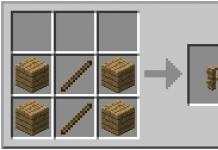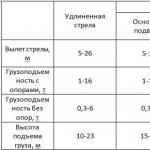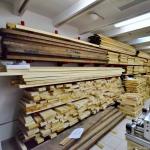Lintels, vaults, brick arches are today, rather, a tribute to the exterior design of the building. The device of wedge-shaped, arched lintels allows you to fit a modern building into the existing building of the past. Arches and vaults are an integral part of many types of stoves and fireplaces. The proposed technology of laying brick openings will help to perform the work efficiently.
Varieties of brick covering of openings
A lintel is a covering of a door or window opening. Reinforced concrete lintels have received the greatest application in construction. They can cover long spans and withstand heavy loads.
Brick lintels are used only for non-load-bearing walls, as they do not have sufficient strength for this. The width of the span in this case should not exceed 1.7 m.
 1 - ordinary; 2 - wedge; 3 - bow; 4 - beam arched
1 - ordinary; 2 - wedge; 3 - bow; 4 - beam arched
Ordinary brick lintels are called ordinary. The brick in them is supported by reinforcement. As an architectural detail of the facades, wedge-shaped, arched, lancet, arched, semi-circular and box lintels are used.
 1 - semicircular; 2 - lancet; 3 - box
1 - semicircular; 2 - lancet; 3 - box
Their variety is due to the shape of the opening, or rather, the outline of its upper part. According to the principle of an arched lintel, vaults are laid out, which are the overlap of buildings.
Before the invention of concrete (the end of the 19th century), the openings were covered with brick lintels. It was not only a tribute to beauty. The wedge-shaped and arched ceilings of the openings kept the load from the wall due to the expansion, which provided a fan arrangement of the bricks in the masonry.

In temple architecture, arches and vaults, as a way of covering openings and rooms, eventually became the canon of church architecture. Modern brick arched openings and vaulted ceilings are only an architectural solution.
The use of arched or wedge-shaped lintels is necessary in the reconstruction of buildings and structures of the 17th-19th centuries.

Furnaces, fireplaces are still being built in almost every country house, where arched or wedge-shaped lintels and barrel vaults are often used in the construction of a stove or guardianship.

Ordinary jumpers
Ordinary jumpers are made according to the principle of ordinary brickwork. It is also carried out with dressing and ensuring the horizontal and vertical seams. Its difference from simple masonry is the observance of a special quality of work. It is necessary to carefully fill the joints to create a joint work of all the bricks of the opening overlap.
Ordinary lintels, unlike conventional masonry, not only compress under the weight of the overlying wall, but also bend without having support in the opening. The size of the brick lintel is taken from the calculation of its work in the opening for bending. The height is 5, 6 rows of masonry. In length, the size is considered to be the width of the opening plus 500 mm on each side of it.

Due to the special importance of the design of the overlap of any opening, the brick is selected for masonry, the brand of mortar is used at least 25. In an ordinary lintel, the brick rests on reinforcement, which is embedded in a layer of cement-sand mortar.
Reinforcement is assigned by calculation and depends on the magnitude of the load on the opening. With their small values, the reinforcement is installed structurally from round steel with a diameter of 4-6 mm. At the same time, its quantity is - one rod per half brick of the wall. The reinforcement should go into the masonry beyond the edge of the opening by at least 250 mm. Their ends are bent up around the brick.
 1 - fittings; 2 - solution; 3 - formwork
1 - fittings; 2 - solution; 3 - formwork
For the device of an ordinary jumper, like any other, you will need a tool that is used for ordinary brickwork. To make a reinforced brick support, formwork must be installed. It can be made from boards with a thickness of 40-50 mm.
You can avoid the leakage of the solution and give the bottom of the jumper a more even look by laying any rolled waterproofing or a simple plastic film on the boards. It must be remembered that irregularities on the surface of the formwork will affect the appearance of the upper part of the opening.

A mortar layer is spread on the formwork, on which reinforcing bars are laid and sunk into it. Then a second layer of mortar is laid, which covers the reinforcement. It is important to observe the thickness of the protective layer for metal products. It is at least 3 cm.
During hardening, the mortar must gain the necessary strength so that further laying of the jumper can be carried out. The period of keeping it in the formwork is at least 12 days in summer, in autumn - at least 20 days. During the period of negative temperatures, it is necessary to comply with special measures developed for winter masonry.
To support the formwork, bricks are released from the masonry, which are subsequently cut down after gaining full strength with mortar and removing the boards. It is possible to arrange a furrow in the masonry and bring a formwork into it, after removing which a brick with a masonry joint is installed in this place.
 1 - formwork; 2 - release of bricks
1 - formwork; 2 - release of bricks
Large openings (wider than 1.5 m) require the installation of racks under the formwork. You can install the support boards under the flooring for rigidity on the edge.
Wedge jumpers
Wedge lintels do not require reinforced mortar support. The bearing capacity of such a jumper arises due to the thrust in the wedge-shaped brick installation.
Exists for the variant of the wedge-shaped jumper device:
- wedge-shaped vertical masonry seam;
- wedge-shaped brick.

In the case of a wedge-shaped seam, its thickness from below is assumed to be at least 5 mm, and from above - no more than 25 mm. If wedge brick is used, the seam in the masonry is made of the same thickness no more than 10 mm. Wedge lintels are installed using formwork with circles.
If a window or doorway is laid with quarters, then three circles will be required to build a wedge-shaped lintel. One is made shorter and installed at the level of the quarters, the other two are inside the opening. Formwork is laid on longer circles, which can be made from boards.

The wall is laid to the level of the upper part of the lintel with the device of the heel (support). In this case, the angle of inclination of the edge of the jumper (bricks) relative to the vertical is immediately determined. Next, you need to mark all the rows on the formwork of the future floor. Their number must be odd. It is important when calculating the device of each row to take into account the thickness of the seam.
The central brick row is inserted vertically and is a lock. It creates compression at the bottom of the lintel and makes it possible to withstand the overlying load without reinforcement.
 1 - lock; 2 - heel
1 - lock; 2 - heel
They begin laying the wedge-shaped lintel from the heels to the middle from two sides, in order to eventually approach the central brick - the castle. You can maintain the exact direction of each seam by finding the point of intersection of the direction lines of both heels. A nail is driven into this place on the formwork and with the help of a rope tied to the nail, the line of each seam is determined.
Arched lintels, arches and vaults
The principle of the construction of arched ceilings of openings and vaults does not differ from the laying of wedge-shaped lintels. The shape of the arch can be arched, lancet, semicircular, box. Their difference lies in the choice of the center, the size of the segment and the radius of the circle.

In any case, the center line of the seam is perpendicular to the inner surface of the lintel or arch. A curved line is formed by a wedge-shaped seam or a wedge-shaped brick. In the case of an arched opening, the center line of the seam is a continuation of the radius of the curve.
 Calculation of the arched lintel: 1 - onion arch; 2 - semicircular arch; h is the height of the arc; s is the width of the window or door opening; r is the radius of the arc
Calculation of the arched lintel: 1 - onion arch; 2 - semicircular arch; h is the height of the arc; s is the width of the window or door opening; r is the radius of the arc
The thickness of the seams is taken, as in wedge-shaped jumpers:
- at least 5 mm - for the lower part of the vertical seam;
- maximum - 25 mm - for the upper part.
 1 - lintel brick; 2 - wedge-shaped solution; 3 - castle brick; 4 - circled
1 - lintel brick; 2 - wedge-shaped solution; 3 - castle brick; 4 - circled
The shape of the formwork is made in accordance with the chosen shape of the ceiling. Checking the radial direction of the seams and the correctness of the curvature of the arches is carried out with a rope tied to the center of the circle of each section of the jumper. You can make a template-gon for the desired shape of a semicircle or segment.

The arches are laid out according to the principle of an arched lintel. Vaults today are erected in the construction of public buildings, churches or temples. For their device, a continuous formwork of the required shape is made. Cylindrical vaults are often laid out in a "Christmas tree". Masonry is carried out simultaneously parallel to the axis of the vault and in rows at an angle of 45 °.
Wedges are placed under the formwork, which are gradually removed during stripping to ensure its uniform lowering. Fresh masonry is very sensitive to stress. You can not put containers with mortar on it or place bricks for masonry. This can lead to a distortion of the shape of the floor and a violation of the bonding of the brick with the mortar.

Vaults and arches of complex configuration require a highly qualified bricklayer, and it is better to entrust the work to a specialist. Having understood the intricacies of the technology of brick ceilings of openings, the construction of lintels and arches of a simple configuration will not be difficult.
Brick lintels, arches and vaults, which came from the past, will still decorate the facade of the house, fencing, small architectural forms, fireplaces and stoves, harmoniously fitting into the interior or exterior of almost any architectural style.
Have you ever wondered how you can transform the look of your home?
If you contact experienced architects or renovation specialists, they will advise you on decor such as a brick arch. And indeed, when you pay attention to an elite mansion, you will surely come across arched vaults. They emphasize the status and grandeur of the owner of the house and adorn any style of decoration of the facade of the building and internal transitions. In this case, you may want to do the same at home, replacing the door with an arch.
Finishing instead of a doorway
In the article we will tell you how to make an arched arch of brick with your own hands.
Varieties
When the conversation turns to the arched vault, you need to clarify what kind you mean. The fact is that there are several of them and each of them is unique and individual in its own way. The laying of these brick arches in each of the types is carried out in its own way.
The arched vault is a semicircle in the opening between two vertical bases, which are the walls of the building. As for the mentioned species, there are three of them.
 Arched vault on the street
Arched vault on the street In the first place is the usual or, as it is also called, the full arch. This variety is considered one of the most popular for a number of reasons. About this kind, we can safely say that it is made simply, but tastefully. A vault of this type is made in the form of a regular semicircle.
In addition, if you have chosen this type of arch, you can easily lay it out yourself.
In second place is a wedge or rectangular arch. Posting it without proper experience is problematic. Therefore, this is not the best choice, even for people who are used to doing everything on their own, according to instructions found on the Internet. This warning is relevant because without proper experience, you run the risk of building an arch that will not last even a couple of years. Outwardly, it looks good and resembles the letter P.
In the last, third place, there is a bow arch. Its arch has an underestimated semicircle.
 Types of arches and opening in a brick wall
Types of arches and opening in a brick wall Before you choose what type of arch you would like to see in your home, you should talk about some of the nuances, such as the distance between the supporting columns.
You will not lay out a wedge arch in a wide opening. This limitation is explained by the fact that it will not be strong if the distance between the supporting columns is wider than one meter.
For a beam arch, this distance is greater. It can be built between columns located at a distance of up to one and a half meters from each other. If you want an arched vault, and the supporting columns are located at a distance of two or even two and a half meters from each other, then a full arch will do.
These and other parameters can be found by studying the guidelines for calculating the masonry of arches.
Preparation for the masonry process
Before starting work, decide where the arch will be located. The fact is that in most construction manuals, the option is considered when masonry is done from scratch, during the construction of the house itself. In this case, the process is described from the erection of the supporting columns themselves.
 Construction template
Construction template In private cases, the owners remake the passages, creating an arched vault in them. In this case, if necessary, a preliminary punching of the openings themselves in the brick walls is done.
Whichever option you choose, the first step should be masonry and, if necessary, strengthening the supporting columns. Strengthening refers to cases where the planned distance between the columns exceeds one meter. After all, then the load on the supporting columns will increase. Therefore, they lay out a couple of bricks thick.
At this stage, it is worth paying attention to the fact that there should not be a warp between the laid bricks of both arches. Each row of bricks is controlled by a building level.
When you reach the vault, then pay attention to a couple of building tricks. Firstly, a special wooden template will come in handy, which will control the laying of the vault bricks, hold them until the cement mortar hardens. We will look at creating a wooden template later in this article.
Secondly, the cement mortar itself is made thicker than usual, the liquid mortar does not guarantee you that subsequently the masonry will not spread under its own weight.
Wooden template
This template is indispensable during the laying of arches with your own hands. To create it, it is enough to have the necessary materials and enthusiasm.
First, find a couple of sheets of chipboard. They will later become the basis of the future template. From the prepared sheets, you need to cut out two identical semicircles that follow the outline of the planned arch.
 Arch template to lay out with bricks
Arch template to lay out with bricks After you cope with this task, get a wide board that matches the thickness of the bearing support. Although a narrow board will do.
On the basis of this board, you need to fix the pre-cut chipboard arch templates with nails. To give the template rigidity, wooden bars are placed between the sheets of chipboard. Thus, you will give the structure the necessary rigidity.
The resulting hollow semicircle of the template must be sewn on top with a steel strip, six or eight millimeters thick. This thickness is sufficient so that the bricks located on top of it do not subsequently push through.
The resulting wooden template is fixed between the lined support pillars of your future arch. To secure, you will have to use wooden spacers, which will be removed later, like the template itself.
The thickness of the selected wooden spacers should be about eight or even ten centimeters. The distance between the spacers is at least half a meter.
arch masonry
So we got to the point where you can start laying the arch. Before you start laying your first bricks, learn one rule. All work on laying the bricks of the vault should be done in one go. In no case should a break be allowed to allow the cement mortar to dry.
 How to lay a template
How to lay a template This rule is due to the fact that during drying, the cement will begin to stretch the bricks to the sides, as it were, creating additional stress. Therefore, if you decide to lay the arch not in one, but in a few days, get ready for the fact that it will eventually crack.
The masonry itself is correct to start simultaneously on both sides of the template, gradually reaching the central part. The last brick, installed in the center of the masonry, will be a kind of castle.
It is characteristic that these recommendations are suitable for any type of arch, no matter what you choose. The only problem that you may encounter is the installation of bricks at certain angles relative to each other, thereby creating an arched semicircle. To simplify this process, they make a preliminary markup on a wooden template, and use a square when laying bricks. Accordingly, during such laying of bricks, the cement mortar will also lie unevenly. Its layer will be thicker at the top of the arched vault.
However, no matter what difficulties you have to face, with due care and assertiveness, you will definitely succeed, and you will correctly build the arched vault of your dreams.
In contact with
Comments
Unfortunately, there are no comments or reviews yet, but you can leave your own ...
New Articles
New comments
S.A.Grade
SvetlanaGrade
SergeyGrade
SergeyGrade
AlexeiGrade
Latest reviews
adminadminMaking a brick arch is not an easy task even for an experienced home craftsman. Such an action requires certain skills and knowledge. And if skills need to be gained in practice, then knowledge can be obtained by reading the recommendations and instructions on how to make a brick arch. For clarity, we provide photos and video materials.
Forms
A do-it-yourself brick arch can be created in a variety of shapes, taking into account the required architectural style. Types of openings, considering masonry:
- classical - the height of the semicircle - half the width of the opening;
- arched - a cropped cone, characteristic of the oriental style;

Construction process
- wedge-shaped - in the form of a wedge, fastened at the top with a locking element, which is typical for the Gothic style;
- modern - an arc like a truncated cone;
- romanticism - rectangular shape with a slight rounding of the corners;
- ellipse - used in postmodern or new wave;
- the portal is rectangular.

This or that masonry of brick arches is characterized by features that need to be taken into account, especially harmony with a certain style.
Subsequence
In general, the procedure is different for all types of arches, but the main stages of this event can be distinguished:
- project creation;
- building a template element;
- its installation;

- masonry;
- removal of the template;
- finishing.
It is worth noting that the template element can be made either from wooden blocks or from chipboard. The sizes are determined in advance. And the attractiveness of brickwork depends on the quality of the template.

What is necessary?
To lay out an arch from a brick, you will need a formwork template, which is made of boards and two racks for support.
Masonry is carried out without gaps, using wedge bricks. The thickness of the joints is up to 1 cm. When using a cement-sand mortar, the template can be removed only after two weeks.
Related article: Instructions for the toilet flush mechanism
If there is no wedge brick, you can redo the rectangular one. For a furnace arch, this parameter should be small. In addition, it is not recommended to use a solution for such a case, otherwise destruction is likely.

Create a template
The template is quite difficult to create. We can say that this stage of construction is the most difficult. After all, the result will be responsible for the shape, and at the same time play the role of a supporting structure. The template is created from a semicircle of chipboard and a piece of board. They should be nailed together, and then the hardboard is fixed.

Installation of support poles
Side supports are made from the boards, for installation on the inside of the columns. A template is installed at the end of these elements. Next, we are engaged in marking, determining the location of each brick.

masonry
Do-it-yourself masonry is easy if you follow certain recommendations. Bricks are laid from the edges to the middle. They must be placed according to the labels on the template. You can control the quality of the arch when there are three bricks left for laying.
The solution should be applied wedge-shaped. To maintain the symmetry of the second row, a cord is used.

It is worth cleaning the solution after it has set. To do this, use a wet brush.
Design features for the garage
You can give a sufficient number of photos of brick arches that are used in garages. To ensure its durability, it is recommended to take into account several features.
For example, many seek to make the arc minimal, but this only reduces the reliability of the design. It is also recommended to correlate the strength of the template and the weight of the arch.

Racks should fit snugly so that the arch does not sag. Before starting the process, determine the required amount of brick. If the arch is large, thick seams should be avoided. The thickness of the bottom seam should be 3-6 mm. Laying is done from the edges to the center. Lay the center brick last.
If the arch is made for a garage, the distance in the opening will be large. To increase the strength of the wall above the arch, it is worth laying reinforcement.
Design features for stoves and fireplaces
In this case, the bricks are fitted tightly so that they touch at the bottom. When the masonry dries, the template can be removed with difficulty. Then there is an alternative - to burn it in the process of burning.





































